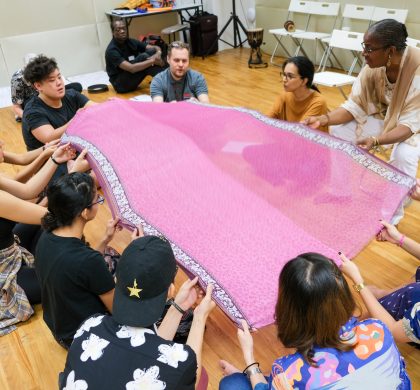Lessons in Innovation: Spotlight on Louisiana Wolf Trap

Sep 25, 2020
Jenny James, Affiliate Director of Louisiana Wolf Trap, Relates How Early Planning and Quick Thinking Helped Her Team Deliver Quality, Engaging Content to their Community During the Pandemic
Without a doubt, this spring was challenging for the education community. Just as most schools turned to virtual learning, Wolf Trap Institute for Early Learning Through the Arts and its affiliates transformed their in-person experiences to virtual ones, in order to continue delivering arts-integrated professional development to educators, and arts-integrated experiences to young children and their families.
As with early childhood educators, the circumstance challenged our affiliates and teaching artists to think differently, and re-think what these types of experiences could look like, without sacrificing the quality and interactivity that have become hallmarks of Wolf Trap classroom residencies and family workshops.
Louisiana Wolf Trap, based in New Orleans and operated through Young Audiences, is one of 22 Wolf Trap affiliates that deliver arts-integrated services for Wolf Trap Institute throughout the United States and Singapore.
Based in one of the earliest states seriously affected by the pandemic in the United States, Jenny James, Affiliate Director of Louisiana Wolf Trap, and her team quickly recognized the severity of the issue, and how it was affecting not just their community, but how it would affect educators, students and their families nationwide.
Our biggest challenges were likely not unique to our own community. Issues of equity impact our work and were magnified by the pandemic when considering access to technology, reliable Internet, availability of learning materials, and loss of family income.
Jenny James
Affiliate Director of Louisiana Wolf Trap
In many cases, James and her colleagues were unable to reach families and partner teachers affected by the crisis. Fortunately, the Louisiana Wolf Trap team was able to draw on a number of virtual resources they had created over the previous two years, and use them as a foundation upon which to build the work that followed. Within one month, they launched their first online workshop.
“Our goal was to take what we were already doing and package it into something that could be helpful to educators and families even without the physical presence of a teaching artist,” says James. “We wanted to bring them a genuine arts experience that was similar to the one they are familiar with during live workshops or classes, but we also had to take our medium into account.”
“Two major things we had to consider [in this process] are time and the translation of the art form online,” continues James. “We had to ask what is a reasonable amount of time to expect a child to watch a screen, how can we engage our audience in an impactful way, and how can we provide the personalization of experience online that our students receive in the classroom.”
Throughout the spring and summer, James’ team, spearheaded by Omote Ekwotafia, Louisiana Wolf Trap’s Director of Program Communications, and Program Manager/Documentation Specialist Eddie Lanieri, put their expertise in film and the digital arena to work as they re-imagined their program offerings and transformed the affiliate’s initiatives to the virtual space.Along with Louisiana Wolf Trap’s teaching artists, the staff utilized a variety of social media platforms including Facebook, YouTube and Instagram to promote and archive their workshops.
They also tapped into Zoom, because of its ability to create an effective interface for both webinars and planning meetings with teachers. This fall, they are using the platform to bring teaching artists into the classroom to interact with teachers and students. Internally, the team also found that Vimeo worked great for cross-team collaboration.
For the 2020-2021 academic year, Louisiana Wolf Trap’s top priority is to simply make virtual learning easy for their schools and students. In the immediate future, they will be working with students only virtually, but have made room for in-person, distanced planning meetings with educators.
Looking forward, James is optimistic that the changes necessitated by the pandemic will ultimately have a positive effect on their community. “Even when the pandemic is a memory, our community has made clear that they have a need for quality engaging content. Families want to know how they can connect with their children, and educators want to find additional tools for their students, but sometimes they just don’t have time,” James says. “Virtual learning has been underutilized and will have to be part of the way forward.”



